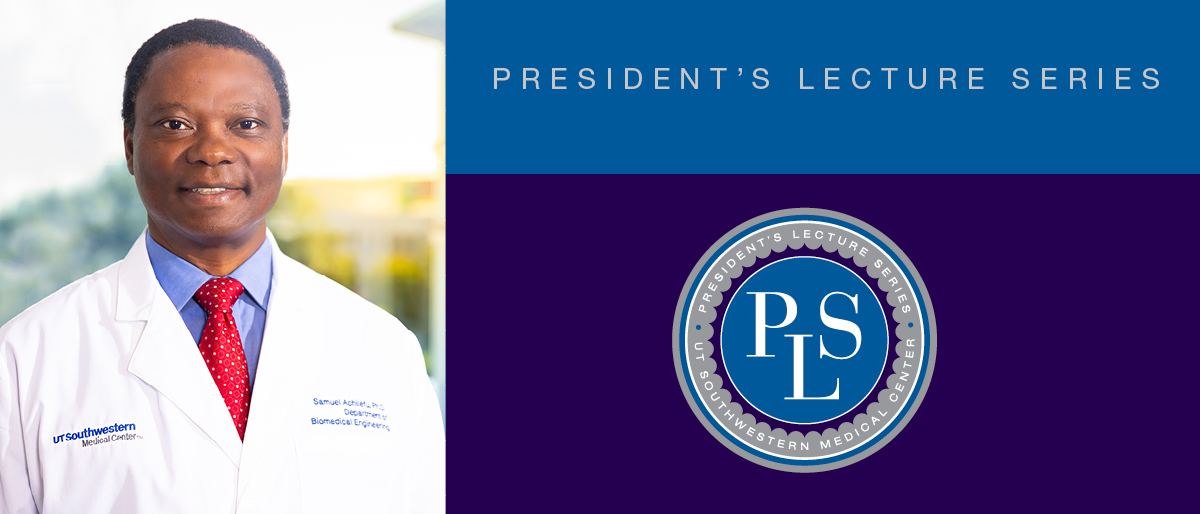President’s Lecture Series: Harnessing the power of light to treat cancer

Biomedical innovator Samuel Achilefu, Ph.D., aims to use the power of light to expose and defend against one of the darkest forces of disease that has affected humankind for millions of years – cancer.
On Nov. 2, as the final speaker in this year’s President’s Lecture Series, Dr. Achilefu will highlight the history of promising fluorescence imaging technology, discuss its current state, and provide a glimpse of what future applications and opportunities may look like. The 4 p.m. lecture by the inaugural Chair of the Department of Biomedical Engineering, titled “Harnessing the Power of Light to Image and Treat Cancer,” will take place in the Tom and Lula Gooch Auditorium on South Campus.
An expert in the molecular imaging of human diseases, Dr. Achilefu utilizes multimodal imaging methods to address technology challenges, focusing on optical platforms. His research interests also include developing portable imaging devices, new imaging methods, and nanotechnology. His seminal work with fluorescent materials for cancer imaging helped found the burgeoning field of near-infrared fluorescence-aided precision medicine. He has launched several basic and clinical translation studies to identify and treat diverse cancer types, especially breast tumors and multiple myeloma.
For many forms of cancer, surgery remains the gold standard of treatment. These procedures rely heavily on visual inspection and physical examination by surgeons as well as intraoperative examination of tumor margins. Common preoperative imaging techniques – including MRI, computerized tomography, and positron emission tomography – are effective but can lead to incomplete tumor removal, which facilitates tumor relapse and can lead to repeat surgery.
In contrast, Dr. Achilefu noted, fluorescence image-guided surgery (FGS) often provides useful information about tumor locations and the extent of the disease in real time during surgery.
“FGS uses materials that highlight tumors selectively and devices that capture these signals, allowing the detection and removal of cancer cells with high precision. We developed a small fluorescent molecule that can find different types of cancer and amplifies its signal in tumor tissue,” said Dr. Achilefu, who also holds appointments in Radiology and the Harold C. Simmons Comprehensive Cancer Center.
In another innovation, Dr. Achilefu, a member of the National Academy of Medicine and a Fellow of the National Academy of Inventors who holds 67 U.S. patents, has developed Cancer Viewing Glasses (CVGs) that can provide real-time guidance to surgeons in the operating room to ensure the complete removal of cancerous tissue.
“Combining light, cancer-illuminating molecules, and CVGs enhances surgery by helping surgeons locate and remove cancers more precisely. The CVGs detect near-infrared fluorescence (NIRF) from cancer-targeting molecular probes,” Dr. Achilefu said.
“Aided by a new fluorescent molecular probe capable of accumulating in most solid tumors, these CVGs have provided real-time image guidance for complete tumor resection in mouse models and cancer patients,” he added.
Dr. Achilefu’s understanding of this multidisciplinary research exploring promising new technology comes from his educational background. He studied chemistry and materials science at the University of Nancy in France as a French Government Scholar before completing postdoctoral training in oxygen transport in biological systems and hematological science at Oxford University in the United Kingdom and then medical imaging at Mallinckrodt Medical Discovery Research in St. Louis.
Prior to joining UTSW in early 2022, Dr. Achilefu worked for more than 20 years at the Mallinckrodt Institute of Radiology and the Department of Biomedical Engineering at Washington University School of Medicine in St. Louis. There, he served as Director for the Biophotonics Research Center, Washington University Molecular Imaging Center, and the Center for Multiple Myeloma Nanotherapy. In 2020, he was appointed by the U.S. Secretary of Health and Human Services to serve on the National Advisory Council for Biomedical Imaging and Bioengineering.
Dr. Achilefu, a Cancer Prevention and Research Institute of Texas (CPRIT) Scholar, received a Recruitment of Established Investigators Awards from CPRIT, which has awarded more than $3 billion in grants to Texas research institutions and organizations through its academic research, prevention, and product development research programs.
UT Southwestern’s Department of Biomedical Engineering, established in 2021, strives to transform the current disease-care model into a genuine health care enterprise while continuing a UT System partnership. In 1974, UTSW founded the first Ph.D. biomedical engineering (BME) program in Texas in collaboration with the engineering schools at UT Arlington and UT Dallas. Under Dr. Achilefu’s leadership, the Department that is housed in the new Texas Instruments Biomedical Engineering and Sciences Building is driving integration in biomedical engineering and addressing emerging clinical and scientific challenges in medicine and biology.
A diverse faculty pool of more than 100 engineers, physicians, geneticists, chemists, mathematicians, and physicists gives learners the opportunity to gain knowledge and grow in an interdisciplinary environment that encourages rotating across tracks and exercising the freedom to discover passions and key areas of interest. UT Southwestern's Biomedical Engineering Department is now among the most highly ranked programs in Texas and the nation, according to U.S. News & World Report.
Dr. Achilefu holds the Lyda Hill Distinguished University Chair in Biomedical Engineering.

